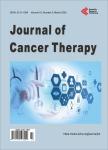Population Pharmacokinetics of UCN-01
Population Pharmacokinetics of UCN-01作者机构:Clinical Pharmacology Research Core National Cancer Institute National Institutes of Health Bethesda USA Department of Pharmacy Practice and Science University of Maryland Baltimore School of Pharmacy Baltimore USA Office of Clinical Pharmacology Food and Drug Administration Silver Spring USA University of Maryland Greenbaum Cancer Center Baltimore USA
出 版 物:《Journal of Cancer Therapy》 (癌症治疗(英文))
年 卷 期:2013年第4卷第10期
页 面:1513-1519页
学科分类:1002[医学-临床医学] 100214[医学-肿瘤学] 10[医学]
主 题:Pharmacokinetics UCN-01 7-Hydroxystaurosporine Pharmacometrics Population Modeling Phase I Clinical Pharmacology
摘 要:UCN-01 (7-Hydroxystaurosporine) is an investigational anticancer agent that is currently being evaluated as targeted therapy in phase II clinical studies. The aims of this work were to describe the population pharmacokinetics of UCN-01 in patients with advanced solid tumors, and to identify covariates in patients with advanced solid tumors that affected the pharmacokinetic parameters of UCN-01. The utility of performing this research is to provide optimization of treatment and individualized dose therapy for minimization of toxicity. So, in addition to elucidating the population pharmacokinetic parameter estimates from a Phase I trial where UCN-01 was given in combination with carboplatin in patients with advanced solid tumors, and a trial where the drug was given alone as a 72-hour infusion in the same type of population, a covariate analysis was performed in order to identify pharmacokinetic determinants of UCN-01. Using NONMEM to perform nonlinear mixed-effects modeling, a linear two-compartment model was found to provide the best fit for UCN-01 data. A meta-analysis was performed, which included pooled 3-hour and 72-hour infusion data, and provided population pharmacokinetic estimates for CL (0.0157 L/hr [6.1%RSE]), V1 (2.51 L [10.0% RSE]), Q (4.05 L/hr [14.3% RSE]), and V2 (8.39 L [6.6% RSE]). Inter-individual variability was found for each of the main pharmacokinetic parameters to be ETACL (44.9% [20.8% RSE]), ETAV1 (43.9% [39.8% RSE]), ETAQ (6.09% [62.5% RSE]), and ETAV2 (4.17% [30.0% RSE]). Body surface area was found to be a statistically-significant variable from one of the individual study analyses (3-hour infusion). Population PK modeling has contributed to a better understanding of the clinical pharmacology of UCN-01. Dose individualization may improve treatment with UCN-01. Further clinical development may be supported by optimization of combination chemotherapy.



